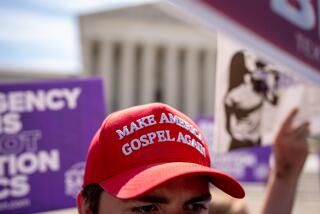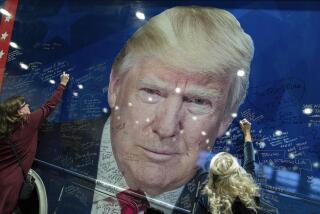Essential Politics: Clinton and Trump look beyond their bases in a polarized country
For all the talk about divisions within the two major parties over their presumptive nominees, the story of the past month has been the speed with which voters in both have fallen into line: The most recent polling averages show Hillary Clinton receiving eight in 10 Democratic votes and Donald Trump getting almost as high a level among Republicans.
If Clinton and Trump are both so unpopular, why have their parties coalesced so quickly?
A new Pew Research Center survey provides a pretty good answer – and a guide to what we should expect the rest of the campaign season.
Good afternoon, I’m David Lauter, Washington bureau chief. Welcome to the Friday edition of our Essential Politics newsletter, in which we look at the events of the week in the presidential campaign and highlight some particularly insightful stories.
ANTIPATHY AND MISTRUST
Nearly half of Republicans regard Democrats as more “immoral,” “lazy” and “dishonest” than other Americans; seven in 10 Democrats view Republicans as “more closed-minded,” Pew found.
And overall, about half of the voters polled said the other party makes them “angry” or “afraid.”
It’s always been true that some partisans mistrust the other side, but the sort of widespread antipathy that Pew found is truly something new in the past decade. The share of Democrats and Republicans who hold “very unfavorable” views of the other party has doubled just since 2000.
In that environment, it’s no surprise that large shares of voters dislike either Clinton or Trump. It’s also no surprise that on both sides, the vast majority of voters will override their doubts and cast a ballot for their party’s leader.
For more on the Pew survey, and its implications, check out my article from Wednesday.
With such a polarized electorate, who wins depends on two factors – the gap in turnout between one side’s backers and the other’s and a relative handful of swing voters in a few battleground states.
The Trump campaign is counting on a turnout surge – a huge outpouring of blue-collar, white voters in states like Pennsylvania, Michigan and Ohio, where Trump’s nationalist, protectionist message clearly has an audience.
The Clinton campaign is counting on a big turnout of minority voters, impelled in part by fear of Trump. She also hopes to win over a small, but potentially critical, slice of Republicans – college educated, moderate, suburban and mostly female.
That Clinton strategy got a boost on Wednesday when the former secretary of State won the endorsement of Brent Scowcroft, the national security adviser to President George H.W. Bush and an adviser to the last four Republican presidents.
The impact is not from Scowcroft, himself – his is hardly a household name – but what he presages: Many in the Republican foreign policy establishment distrust Trump enough to override partisanship, and their views could have a significant effect on the voters Clinton hopes to sway.
THE ‘BREXIT’ VOTE
The Scowcroft endorsement shows one part of the country’s governing class – the foreign policy elite – gathering behind Clinton. The British vote Thursday to quit the European Union shows the potential for working class voters to revolt against that elite, spurning warnings that the rejection will work against them.
The parallels between the “Brexit” movement and the Trump campaign are ample; so are the differences. What lessons does the British vote have for the U.S.? Check out my story.
DON’T FORGET THE ELECTORAL COLLEGE
The popular vote is all very well – just ask Al Gore – but gaining the presidency requires winning enough states to get 270 electoral votes. How to get there? Play political strategist for yourself, and try out as many scenarios as you like on our electoral map.
QUESTIONS ABOUT TRUMP? CLINTON? WE’VE GOT ANSWERS
Where they stand on issues, what they’ve done in their lives, their successes, their failures, what their presidencies might look like: We’ve been writing about Clinton and Trump for years, and we’ve pulled the best of that content together to make finding what you want to know easier. So check out All Things Trump and All Things Clinton.
DUELING SPEECHES, DIVERGENT DOLLARS
Three weeks have passed since Clinton clinched the Democratic nomination, and the general election campaign is already on full boil.
This week, the Clinton campaign started advertising on television in eight battleground states – Nevada, Colorado, Iowa, Ohio, Florida, North Carolina, Virginia and New Hampshire, outspending Trump’s campaign $23 million to $0. The two candidates have been directly engaging. Trump’s dismal fundraising in May caused further panic among Republicans. The New York businessman fired his campaign manager. And the vice presidential sweepstakes are well underway.
Here’s what we’ve been writing.
Clinton delivered two speeches on the economy this week. As Mike Memoli noted in his story examining her economic message, Tuesday’s speech was heavy with warnings about Trump.
“Just like he shouldn’t have his finger on the button, he shouldn’t have his hands on our economy,” she said.
Both in that speech in Ohio and in a follow-up the next day in North Carolina, Clinton stuck to the liberal economic themes that she hit during the primaries. The speeches served notice that while she’s likely to try to reach out to Republicans and more conservative voters on foreign policy, Clinton plans to stick to a progressive message on the economy, one that her strategists hope will connect with some of the economically stressed voters who might otherwise be attracted to Trump.
The Republican fired his return volley on Wednesday. As Noah Bierman reported, it was a blistering speech that combined a protectionist economic message with sharp attacks on Clinton. For a speech by a presidential candidate, it also contained an astonishing number of false statements and unsubstantiated insinuations, providing lots of work for fact-checking efforts.
As Cathy Decker wrote in her analysis, the whole performance raised the question of whether Trump is too flawed a messenger to successfully take advantage of the voter anger that fuels his campaign.
Meantime, both candidates are vetting possible running mates. Mark Barabak took a close look at the question of whether prominent Republicans would really want to be Trump’s running mate. He also examined the list of potential vice presidential candidates on both sides, looking at their pros and cons.
One person who won’t be on the VP list: Sen. Marco Rubio. The Florida senator decided, after weeks of back and forth, that he’ll run for reelection. His decision, Lisa Mascaro reported, turns the Florida race into one of the marquee Senate contests of the year.
LOGISTICS
If you like this newsletter, tell your friends to sign up.
That wraps up this week. My colleague Christina Bellantoni will be back Monday with the weekday edition of Essential Politics. Until then, keep track of all the developments in the 2016 campaign with our Trail Guide, at our Politics page and on Twitter @latimespolitics.
Send your comments, suggestions and news tips to politics@latimes.com.
Miss yesterday’s newsletter? Here you go. Did someone forward you this? Sign up here to get Essential Politics in your inbox daily.
More to Read
Get the L.A. Times Politics newsletter
Deeply reported insights into legislation, politics and policy from Sacramento, Washington and beyond. In your inbox three times per week.
You may occasionally receive promotional content from the Los Angeles Times.











